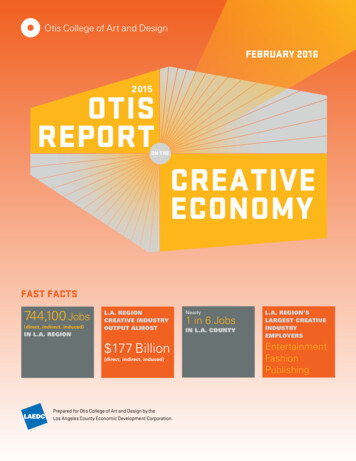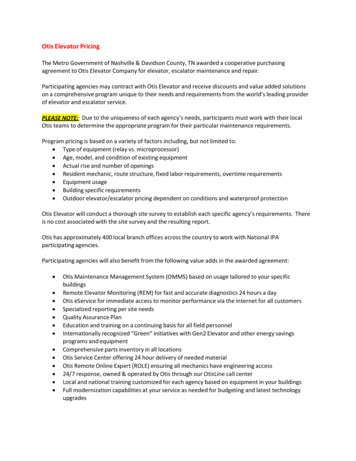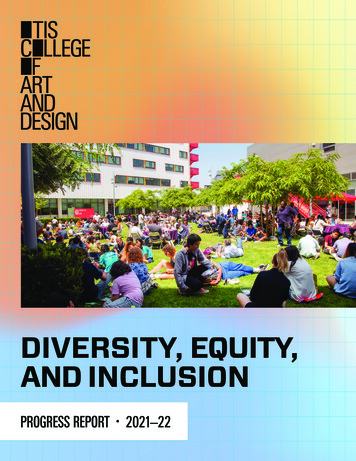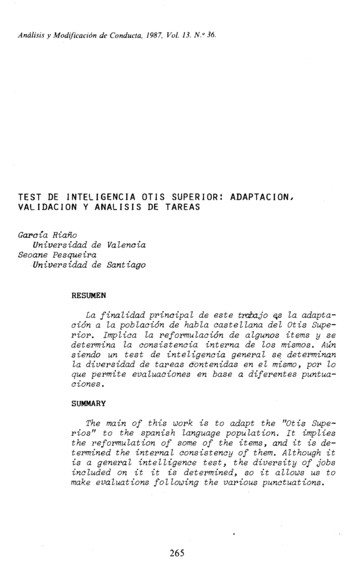
Transcription
FEBRUARY 2016LOS ANGELES REGIONFAST FACTS744,100 Jobs(direct, indirect, induced)IN L.A. REGIONL.A. REGIONCREATIVE INDUSTRYOUTPUT ALMOST 177 Billion(direct, indirect, induced)Prepared for Otis College of Art and Design by theLos Angeles County Economic Development Corporation.Nearly1 in 6 JobsIN L.A. COUNTYL.A. REGION’SLARGEST shing
EVENT SPONSORSREPORT SPONSORSTHANK YOUDPR ConstructionAr thur J. Gallagher & Co. Bon AppétitManagement Company Hir tle, Callaghan & Co.Moss Adams LLPMEDIA PARTNERSAdditional suppor t provided by Marsh.www.otis.edu/econreport2015 Otis Report on the Creative Economy of the Los Angeles RegionBack to Contents2
2015 Otis Report on the CreativeEconomy of the Los Angeles RegionPrepared for Otis College of Art and Design by theLos Angeles County Economic Development Corporation.www.otis.edu/econreport2015 Otis Report on the Creative Economy of the Los Angeles RegionBack to Contents3
PREPARED AND RESEARCHED BY:PROJECT MANAGED BY:The LAEDC Kyser Center for Economic ResearchOtis College of Art and DesignRobert A. Kleinhenz, Ph.DChief EconomistMatthew TecleSpecialist Institutional AdvancementKimberly Ritter-MartinezEconomistArleen ChikamiAssistant Director of Strategic PartnershipsBengte Evenson, Ph.DEconomistClaudia Beinkinstadt KrumlaufDevelopment & Special Events ManagerGeorge EntisResearch AnalystChelsey SobelCoordinator, Institutional AdvancementThe LAEDC Institute for Applied EconomicsAnne Swett-PredockCreative DirectionChristine Cooper, Ph.D.Vice PresidentSean YoonDesign and ProductionDownload the full report, viewhighlights from the creativeeconomy launch event, and learnmore about other resources 15 Otis Report on the Creative Economy of the Los Angeles RegionBack to Contents4
REPORT CONTENTSIntroductionExecutive SummaryWhat Is The Creative Economy?National and Global Economic ContextCreative Industry TrendsEconomic Contribution of the Creative IndustriesLooking Ahead: The Creative Economy In 2019Industry Snapshots68181920313336Architecture and Interior DesignArt GalleriesCommunication ArtsDigital MediaEntertainmentFashionFurniture and Decorative ArtsProduct/Industrial DesignPublishing and PrintingToysVisual and Performing Arts Providers3738394041424344454647Occupations in the Creative EconomyNonprofit Segment of the Creative EconomyArts Education: K-12 And Post SecondaryHow to Use This ReportStatistical AppendixIndex of 2015 Otis Report on the Creative Economy of the Los Angeles RegionBack to Contents5
BRUCE W. FERGUSONOTIS INTRODUCTIONPRESIDENTOTIS COLLEGE OF ART AND DESIGNFor nearly a decade the Otis Report on the Creative Economy (Otis Report) hasillustrated the enormous impact the creative industries have had on the health andstability of the overall economy. Since 2007, Otis has commissioned theLos Angeles County Economic Development Corporation (LAEDC) to measure,assess, and project the economic impacts of the creative industries in theLos Angeles region. The Otis Report has expanded and flourished over the yearsto become a powerful advocacy tool for the nonprofit arts community, bringingtogether leaders across disciplines and sectors to advance policies in support ofarts education, and inspiring countless municipalities, both in the U.S. and abroad,to research and document the economic contributions of artists and creativebusinesses in their own communities.In 2013, with the generous support of the California Arts Council, Otis and theLAEDC were able to broaden the scope of analysis to include a statewide report.2015 marks the third iteration of the annual Otis Report on the Creative Economyof California. The full California Report will be unveiled at a public hearing inSacramento before the Joint Committee on the Arts—a committee consistingof representatives from both the California Senate and Assembly. Furtherinformation on the release of the statewide report can be found at the CaliforniaArts Council’s website, at http://www.arts.ca.gov.New to this year’s Otis Report is a comparative analysis of the number and relativeconcentration of creative jobs in the top five Metropolitan Statistical Areas ofthe United States. Specifically, L.A.’s Statistical Metropolitan Area (also referredto as the L.A. region in this report) contains over 418,000 creative jobs out of thetotal 4,955,400 salary and wage jobs in the area—a share of over 8.4%. New York’sMetropolitan Area comes in second with 402,000 creative jobs out of 7,515,400,which translates to 5.4% of the share. Chicago comes in third with 133,800 jobsout of 3,794,400, or around 3.5% of the total share of salary and wages jobs. Thereis no other metropolitan area that can boast the highest number and greatestconcentration of creative industries jobs as Los Angeles.Here are a few highlights of the 2015 Otis Report related specifically to theLos Angeles region: The total economic output of the creative industries in 2014 totaled 176.9billion (direct, indirect, and induced effects), which corresponds to nearly13% of the region’s gross domestic product of 861 billion.The creative industries in the L.A. region generated an additional 7.7 billionin tax revenue (property, state, local personal income, and sales), whichwas nearly half of the 15.5 billion in tax revenues generated by creativeindustries statewide.www.otis.edu/econreport2015 Otis Report on the Creative Economy of the Los Angeles RegionBack to Contents6
The creative industries in the Los Angeles region include over 744,100jobs (direct, indirect, and induced).These jobs had a total labor income of 53.4 billion (direct, indirect,and induced).OTIS INTRODUCTION The Otis Report demonstrates that creativity and innovation thrive in Los Angeles,and the current renaissance happening throughout the city echoes this. Newbusinesses, motion picture and television studios, restaurants, museums, startups, and tech hubs exhibit how the creative economy is intimately tied to the healthand well-being of our citizens and communities. In an increasingly globalizedworld, where creative thinking and innovation are at the core of advancement, it iscritical that leaders from the public, private, and nonprofit sectors work together tonurture and challenge the creative economy to continue to flourish and thrive.AKNOWLEDGEMENTSThis year’s Otis Report would not have been possible without the generous supportof the many organizations and companies that have invested their resources toadvance creativity and innovation in our community. On behalf of the College,I would like to express my deepest appreciation to the Los Angeles CountyEconomic Development Corporation’s Kyser Center for Economic Research foragain creating a compelling and rich analysis.I would also like to thank our report sponsors for their incredible support andleadership: the California Arts Council, Mattel, the City of Los Angeles, Departmentof Cultural Affairs, and City National Bank. Special thanks to this year’s eventsponsors include our friends at DPR Construction, Arthur J. Gallagher & Co., BonAppétit Management Company, Hirtle, Callaghan & Co., and Moss Adams LLP.Additional support was provided by Marsh. Thank you to our media partners Artsfor LA, Arts Orange County, Californians for the Arts, and LAX Coastal Chamberof Commerce.Finally, thank you and congratulations to our creative colleagues for their successand determination in making Los Angeles the creative epicenter of the globe. Welook forward to continued growth and many more triumphs in the years to come.Bruce W. FergusonPresidentOtis College of Art and DesignOtis prepares diverse students of art and design to enrich our world through their creativity, their skill, and theirvision. The College offers an interdisciplinary education for approximately 1,200 full-time students, awardingBFA degrees in Architecture/Landscape/Interiors, Communication Arts, Digital Media, Fashion Design, FineArts, Product Design, and Toy Design, and MFA degrees in Fine Arts, Graphic Design, Public Practice, andWriting. Through Continuing Education & Pre-College Programs, Otis offers a wide range of art and designcourses and programs for all ages, including children and teens. For information, visit www.otis.edu.www.otis.edu/econreport2015 Otis Report on the Creative Economy of the Los Angeles RegionBack to Contents7
EXECUTIVE SUMMARYThe creative industries of the Los Angeles region (Los Angeles and Orangecounties) turned in a solid performance in 2014 in terms of employment, laborincome, and output. Over the five year period covered in this report (2009 to 2014),direct wage and salary employment in the region’s creative industries increasedby 11,400 jobs (up by 2.8%) to 418,200. This was a considerable improvement overthe previous five-year cycle (2008 to 2013) during which, employment contractedby 48,000 jobs (down by 10.5%). In spite of the improvement, however, job growthin the creative sectors lagged the 8.3% growth rate recorded for all of region’sindustries from 2009 to 2014. Much of the difference can be explained by thecreative economy’s higher concentration of manufacturing jobs, which have notfared as well as jobs in other parts of the economy in the aftermath of theGreat Recession.The Los Angeles region can clearly lay claim to being the Creative Capital of theU.S. With more than 418,000 wage and salary workers in the creative industries,the Los Angeles region is home to the largest number of creative workers of anymetropolitan area in the country, outdistancing the New York City metropolitanarea by 14,000 jobs, despite New York’s larger job base. Chicago is a distant thirdwith 134,000 jobs, while San Francisco and Seattle are fourth and fifth, each withfewer than 100,000 creative economy jobsTotal direct labor income in the creative industries of the Los Angeles regionamounted to 36.1 billion in 2014 or 13.1% of the annual private sector wage andsalary payroll in the region. Of that total, the entertainment sector contributed 15.1 billion (primarily motion picture and video production) or nearly half of thetotal (41.7%), followed by the visual and performing arts at 6.0 billion, and fashionat 4.2 billion.In addition to wage and salary employment, growth in the creative industries is alsodriven by talented self-employed individuals. In 2013 (latest data available), therewere 166,404 nonemployer firms in the Los Angeles region’s creative industriesthat earned revenues of 7.7 billion. Between 2008 and 2013, the number of selfemployed workers in Los Angeles and Orange counties increased by 15.0% (21,682firms), slightly outpacing the region’s 14.4% increase across all industries.While direct job counts in the creative industries of the Los Angeles region wereimpressive (418,200 in 2014), they were only one part of a much larger employmentpicture. Direct employees are those who work in the creative industriesthemselves. Indirect jobs are created when firms in those industries makewww.otis.edu/econreport2015 Otis Report on the Creative Economy of the Los Angeles RegionBack to Contents8
purchases from their suppliers and vendors. Additional induced jobs are generatedwhen the direct and indirect employees spend their wages on consumer goods andservices. In that sense, every job within the creative sector supports or sustains otherjobs in the region.Direct, indirect and induced employment in the creative industries of the Los Angelesregion totaled 744,100 jobs in 2014, up from 695,100 in 2013. The labor incomeearned by these 744,100 million wage and salary workers was 53.4 billion. Activityin the creative sectors not only triggers jobs and spending, but it also results intax revenues for state and local government that help to fund local services likeeducation and public safety. Property taxes, state and local personal income andsales taxes generated directly and indirectly by the creative industries were 7.7billion across the region in 2014.The creative industries of Los Angeles and Orange County also generated 176.9billion in economic output. Of that, 109.1 billion was value-added (corporate profitsand labor income). This net economic contribution was the equivalent of 12.7% of theregion’s gross product ( 860.6 billion) in 2014, up from a share of 10.6% in 2013, anindication that the contribution of the creative industries to the region’s economyis growing.The Los Angeles region continues to make steady economic progress. Over theperiod 2014 to 2019, wage and salary employment in Los Angeles County is expectedto grow by 4.5% and in Orange County by 8.0%. However, the LAEDC projectscreative industry employment will grow faster over that period in both counties.Creative employment is expected to increase by 7.0% in Los Angeles County from360,300 wage and salary jobs in 2014 to 385,400 in 2019 1. In Orange County, creativeeconomy employment is expected to increase by 9.7% from 53,400 jobs to 58,100over the same period.1Employment forecasts donot include employmentat fine and performingarts schools.All of the creative industries in both counties will experience wage and salary jobgains. With a long-awaited lift off in the housing market anticipated in 2016, therewill be increased demand for architecture and interior design, as well as furnitureand the decorative arts. This will drive demand upstream to industrial design. Asthe national and state economies continue to expand, household expenditures onart, entertainment and toys should grow and lend support to the creative industries.Throughout this period, job gains will gradually narrow but not close the gap betweencurrent creative economy employment and the pre-recession peak level of 464,200jobs that prevailed in 2007.As demonstrated above, the creative industries of the Los Angeles region makea significant contribution to economic growth and employment. They also fosterinnovation and spillover effects that enhance other industries. The creativeindustries help drive the region’s economy by attracting investment, tourism,consumer spending and by generating tax revenues. In a post-industrial society,www.otis.edu/econreport2015 Otis Report on the Creative Economy of the Los Angeles RegionBack to Contents9
activities based on creativity and culture are an essential feature of a flourishingeconomy. Creativity and culture also have a non-monetary value in that theycontribute to inclusive social development, dialogue and understandingbetween people.Given the large economic contribution of the creative industries to the regionaleconomy, it is important to ask how stakeholders can nurture, support and growthe creative economy. Creativity is unique in that it relies on an unlimited resource:human ingenuity. Growth strategies in the creative economy should thereforefocus on harnessing the development potential of this unlimited resource.To strengthen the creative economy, a good place to start is at the beginning ofthe creative pipeline, preK-12 education. Education in the arts is a necessary partof preparing students to meet the demands of the twenty-first century workforcewhere workers now have to compete in a global labor market. Arts educationfosters creative, critical thinking, problem solving and collaboration. In this sense,creativity has become as important in modern education as mastering specificlanguage and computational skills.California has one of the strongest polices on arts education in the nation, butuneven implementation and funding issues have resulted in huge disparities inthe Los Angeles region between schools in affluent areas compared with those inlow income areas. Closing these gaps would go a long way toward creating an evenplaying field for all of the children in the region and ensuring a future workforcewith the skills necessary to gain entry into today’s economy. Additionally,companies’ decisions about where to locate their businesses are often influencedby factors such as the ready availability of a skilled and creative workforce.Support for the creative industries must also include policies and initiativesthat increase the competitiveness of the region’s creative firms and increaseawareness of the state’s creative and cultural products beyond its borders.Initiatives may come from state and/or local governments, but the creativeindustries themselves should play the dominant role in this process.www.otis.edu/econreport2015 Otis Report on the Creative Economy of the Los Angeles RegionBack to Contents10
While it is beyond the scope of this report to recommend specific developmentstrategies, the following is a sampling of strategies that are available: A regional branding initiativeMarketing and partnerships that promote cultural tourismCapacity building through programs that teach business skills to entrepreneurs,professional education, consulting and coaching for business startupsBuilding physical infrastructure (e.g. affordable housing/spaces for artists towork; improving mobility for people and freight)Creative business incubationTraining programs that meet the specific needs of targeted industriesAccess to financeMuch has been written about the need for employees in the new economy to workcollaboratively to facilitate the exchange of ideas that leads to innovation. The sameholds true for firms and businesses. This is one of the primary benefits of industryclustering. While the disparate set of industries that make up the creative economydo not naturally form a cluster, they are a source of significant spillover effects oninnovation and productivity, tourism and branding, education and social innovation.Strengthening ties among the creative industries, as well as those between thecreative industries and the broader economy, would encourage cross-innovation,lend vitality to existing industries, and contribute to the emergence of new industries.www.otis.edu/econreport2015 Otis Report on the Creative Economy of the Los Angeles RegionBack to Contents11
TABLE 1:2015 CREATIVE ECONOMY REPORT: NUMBERS AT A GLANCELos AngelesCountyOrange CountyLA/OC 00744,10018.0%7.0%15.0%Los AngelesCountyOrange CountyLA/OC RegionDirect labor income 32.6 billion 3.5 billion 36.1 billionTotal labor income: direct, indirect and induced 47.7 billion 5.7 billion 53.4 billionLos AngelesCountyOrange CountyLA/OC Region 6.9 billion 0.8 billion 7.7 billion 158.2 billion 18.7 billion 176.9 billionCreative industries value-added(Corporate profits and labor income) 99.4 billion 9.8 billion 109.1 billionTotal regional gross product 634 billion 226.5 billion 860.6 billion15.7%4.3%12.7%Los AngelesCountyOrange CountyLA/OC Region141,95424,450166,404 6.7 billion 1.0 billion 7.7 billion2014 EmploymentDirect JobsDirect creative industries workers as % of allprivate wage and salary workersTotal jobs: direct, indirect and inducedTotal creative industries workers as % of allprivate wage and salary workers2014 Labor Income2014 Taxes and OutputState and local taxesTotal creative industries outputCreative industries value-added as % of gross product2013 Nonemployer FirmsNumber of firmsRevenueswww.otis.edu/econreport2015 Otis Report on the Creative Economy of the Los Angeles RegionBack to Contents12
KEY FINDINGSL.A.O.C.ECONOMIC CONTRIBUTIONLOS ANGELES REGION 2014(L.A. AND ORANGE COUNTIES)TOTAL CREATIVEINDUSTRY OUTPUT 176.9 BILLIONDirect, indirect, andinduced impact.Revenues, Spending, &Economic Activity.TOTAL GROSSREGIONAL PRODUCT 860.6 BILLIONA Net EconomicContribution of 109.1 BILLIONCreative IndustriesContribute12.7%Tax Revenues 7.7 BILLION 860.6 Bwww.otis.edu/econreport2015 Otis Report on the Creative Economy of the Los Angeles RegionBack to Contents13
KE Y FINDINGSL.A.O.C.EMPLOYMENTLOS ANGELES REGION 2014(L.A. AND ORANGE COUNTIES)Direct, Indirect, AndInduced Jobs744,100NUMBER OF CREATIVEINDUSTRY JOBSWage and Salary WorkersCreative Industry JobsAccount for 18% of allworkers in the L.A. region418,200744,100Direct Jobs418,200www.otis.edu/econreport2015 Otis Report on the Creative Economy of the Los Angeles RegionBack to Contents14
KE Y FINDINGSL.A.O.C.JOBSLOS ANGELES COUNTY 201418% of wage and salary employmentL.A.O.C.LOS ANGELES IS THECREATIVE CAPITAL OF THE U.S.TOP 5 CREATIVE METRO AREAS IN THE U.S.Seattle Metro AreaChicagoMetro Area91,900133,800San FranciscoMetro Area95,700New york CityMetro Area402,900Los AngelesMetro Area418,200www.otis.edu/econreport2015 Otis Report on the Creative Economy of the Los Angeles RegionBack to Contents15
About the Kyser Center for Economic ResearchThe Kyser Center for Economic Research was named in November 2007 in honorof the LAEDC’s first Chief Economist, Jack Kyser. The Kyser Center’s economicresearch encompasses the Southern California region, which includes: thecounties of Los Angeles, Orange, Riverside, San Bernardino, San Diego andVentura. The center also tracks developments and produces forecasts, studies,and reports on the California, national and international economies.The economy of the greater Los Angeles region is driven by more than its famedentertainment industry. The region’s broad economic base also includes aerospace,automotive, biotechnology, fashion, manufacturing and international trade. The KyserCenter conducts research on the individual industries of the region to betterunderstand ongoing changes in the economy.The Kyser Center is highly regarded for its accurate and unbiased assessment of theeconomy. Kyser Center economists are also sought-after public speakers andfrequent contributors to media coverage of the economy. At the heart of the KyserCenter is its mission to provide information, insights and perspectives to helpbusiness leaders, government officials and the general public understand andtake advantage of emerging trends. 2016 Los Angeles County Economic Development CorporationThe Kyser Center for Economic Research444 S. Flower St., 37th Floor, Los Angeles, CA 90071Tel: 213-622-4300, 888-4-LAEDC-1 Fax: 213-622-7100www.LAEDC.org research@laedc.orgPrepared for Otis College of Art and Design by theLos Angeles County Economic Development Corporation.www.otis.edu/econreport2015 Otis Report on the Creative Economy of the Los Angeles RegionBack to Contents16
2015 OTIS REPORTON THECREATIVE ECONOMYOF THELOS ANGELES REGIONBack to Contents
WHAT IS THECREATIVE ECONOMY?Creativity is one of the Los Angeles region’s foremost economic assets and thecreative economy is undeniably important to the region’s economic growth. Inthis report, the creative economy is defined as the businesses and individualsinvolved in producing cultural, artistic, and design goods and services. It consistsof creative professionals and enterprises that take powerful, original ideas andtransform them into practical and often beautiful goods, or inspire us withtheir artistry.The creative economy also includes organizations that provide a venue for artiststo share their work with the public such as museums, art galleries and theaters.Finally, the creative economy includes activities one does not instinctivelyassociate with creativity such as apparel, toy and furniture manufacturing all industries that depend on good design.In a broader sense, the creative economy must include a support system thatteaches, nurtures and sustains creative activity: arts programs in preK-12 schools,post-secondary arts institutions to develop talent, and philanthropic foundationsalong with other nonprofit funding organizations to provide financial resources,incentives, and services to the creative arts.In today’s economy, the market value of products and services is increasinglydetermined by a product’s uniqueness, performance and aesthetic appeal. Morecompanies are seeking employees with creativity and out-of-the-box thinking aswell as problem solving and communication skills. Business location decisions arealso influenced by factors such as the availability of a creative workforce and thequality of life available to employees. The talent that drives the creative economyprovides a competitive advantage that reaches across almost every industry in theLos Angeles region.Regions acquire a competitive advantage when they attract creative employeesbecause creative thinkers encourage innovation, which in turn fosters economicgrowth. In recent years, advanced technology jobs have been outsourced in muchthe same way basic manufacturing jobs have been sent offshore. But originalartistic creation, innovative design and other higher-level creative work cannotbe outsourced so easily. Creativity builds brand awareness and attracts talentedpeople to a dynamic environment.www.otis.edu/econreport2015 Otis Report on the Creative Economy of the Los Angeles RegionBack to Contents18
Because creativity is a dynamic function of humanity, the creative economy isa vibrant and vital force in society. Intellectual and aesthetic sensibilities leadindividuals to express themselves through the arts, solve problems throughdesign, and seek out what is beautiful and original. In many ways, the Los Angelesregion is unique because of its combination of place, resources and open attitudestoward new ideas. This openness to new ideas and the ability to make associationsand connections that other people do not see is one of the defining characteristicsof creativity. Here, new ideas are constantly given form and brought to life bycreative people.NATIONAL AND GLOBALECONOMIC CONTEXTThe industries of the creative economy in the Los Angeles region respond tothe ebbs and flows of the overall economy, not just locally and statewide, butnationally and globally as well. This section briefly summarizes recent andanticipated economic conditions and their likely effects on the state’screative industries.The year 2015 was marked by steady growth in the U.S. economy, with grossdomestic product (GDP) expected to match the previous year’s growth rate of2.4%. GDP growth has been modest, but it has also been steady and the sourceof solid job gains for several years running. By 2015, the U.S. was closing in onfull employment with an unemployment rate of 5.0%. This was an importantmilestone for the economy, as it signals a return to a more normal labor market. Atthe same time, a pickup in wage gains drove growth in household incomes, and, inturn, consumer expenditures, which make up two-thirds of the domestic economy.Apart from the energy sector, most industries of the national economy grew,adding jobs and undertaking capital expenditures on technology, equipment, andbuildings. International trade was a mixed bag in 2015. A stronger dollar enabledU.S. consumers and businesses to import more for less, but at the same time itmade it more difficult for U.S. exporters to make sales given weakness among thenation’s major trading partners.GDP growth is expected to accelerate to 2.8% in 2016, with most industries addingjobs and continuing their capital expenditures. Wage gains will spur increases inconsumer spending, while business spending will maintain momentum. Meanwhile,housing and construction is expected to do well as a result of demographicchanges: the oldest Millennials are now in their early thirties, the stage of lifeto form new households and exert greater demand for both rental and owner-www.otis.edu/econreport2015 Otis Report on the Creative Economy of the Los Angeles RegionBack to Contents19
occupied housing. Inflation, which was nearly nonexistent in 2015, is increasingsomewhat but will stay below two percent over the foreseeable future. Finally,international trade will again face challenges in 2016 as the dollar appreciatesfurther and U.S. trading partners see only marginal improvement in theireconomies, if any at all.California has outpaced the nation in terms of both economic growth and jobcreation over the past year. Nearly all of California’s industries added jobs in2015 and will do so again in 2016. With improvements across much of the state,California’s unemployment rate has converged on long-run normal levels. Personalincome, which has improved during the last several years, will grow more quicklygoing forward.What does all this mean for the creative industries of the Los Angeles region? Anumber of creative industries are related directly or indirectly to real estate andconstruction: architecture and interior design, furniture and decorative arts, andproduct/industrial design. These industries should benefit from strength in realestate and construction during 2016. Other creative sectors may be more relianton overall consumer spending or spending by individual consumer segments.These include art galleries, fashion, entertainment, toys, visual and performingarts, and digital media. Continued growth in consumer spending in the year 2016should provide a boost to these industries. Both communications and printing andpublishing may be facing structural changes, but they also tend to be pro-cyclicalwith the overall economy. As such, the outlook for continued growth implies thatthese sectors will see further expansion in the year ahead.CREATIVE INDUSTRY TRENDSEMPLOYMENTA total of 364,200 wage and salary workers in Los Angeles County were employeddirectly in the creative industries in 2014. By sector, the largest employmentcounts were in entertainment (135,200 jobs), fashion (89,200 jobs), and publishingand printing (32,300 jobs). Although Los Angeles’ iconic entertainment industryconsistently employs the largest number of workers by far – over 37% of totalwage and salary employment – the creative economy of Los Angeles is diversewith jobs distributed across a wide array of industries.Direct employment in Los Angeles County’s creative industries reached itspeak in this cycle in 2007 at 400,500 jobs. Like total employment in the region,creative employment fell sharply during the recession. Los Angeles County as awhole re
Architecture and Interior Design 37 Art Galleries 38 Communication Arts 39 Digital Media 40 Entertainment 41 . Through Continuing Education & Pre-College Programs, Otis offers a wide range of art and design courses and programs for all ages, including children and teens. For information, visit www.otis.edu. .










